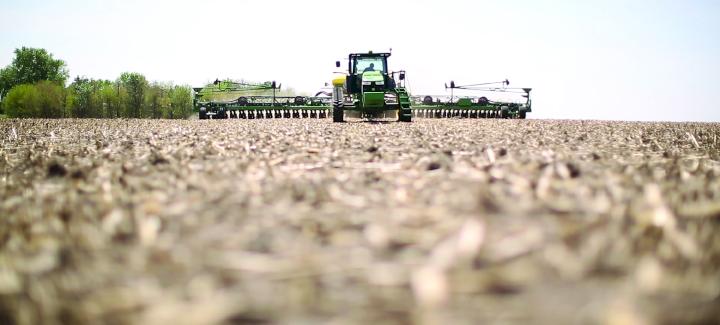
To till or not to till? That question weighs heavy on growers’ minds each spring before planting season. Some growers might go all in with heavy tillage, while others may consider minimum tillage or no-till for a number of reasons. Nevertheless, it’s important to approach tillage by understanding how it affects overall soil health and fertility, in addition to disease, weed and insect pressure.
“Tillage as a whole doesn’t improve soil quality,” says Ian Matzenbacher, technical agronomist for Stine®. “It usually reduces the structure and water-holding capacity of the soil, but it also typically provides short-term relief on weed and disease pressure in addition to fertility.”
Types of tillage
No-till. No-till is exactly as it sounds — a strategy where the soil and residue are left undisturbed after harvest. This can greatly increase the chances of soil-borne pathogens, weeds and insects returning to your fields next season due to overwintering in the soil or on residue of previously infected plants. For growers who experienced heavy insect, disease or weed pressure in 2022, no-till is likely not an effective strategy for 2023. That said, for growers who experienced clean fields, it may be a good way to reduce erosion and keep your nutrients where you need them.
“With no-till, you’re not compromising the soil structure, which acts like a colander of sorts,” says Matzenbacher. “With more tillage, you work that ground to the point where a hard rain can impact the drainage of the soil, leading to more runoff of the soil and nutrients versus allowing the moisture to soak into the ground where it’s needed the most. No-till also helps minimize chances of compaction in your fields.”
Minimum tillage. This very common method is also considered a conservation tillage practice. With minimum tillage, growers lean on vertical tillage tools or field cultivators to work only the surface of the soil, from 1 to 5 inches below ground. This method digs deep enough to deal with foliar or soil-borne diseases and to break up residue. It also aids in killing insects and different pathogens by reducing the habitat for them to thrive in. Minimum tillage works best at reducing erosion and keeping a healthy layer of residue on the soil, along with destroying less root mass.
“Nutrient leaching is greatly reduced with minimum tillage compared to heavier forms of tillage,” says Matzenbacher. “The more nutrients and water-holding capacity you can keep going into the next season should only improve your future crop’s health and, hopefully, yield.”
Heavy tillage. Typically, heavy tillage occurs when growers turn to a disc, plow or any other equipment that moves the soil horizontally instead of vertically. Heavy tillage works the ground from a range of 5 to 10 inches. With the increased depth comes more disturbance in the soil profile and structure.
“Heavy tillage reduces water-holding capacity, increases the chances of erosion and leaching, and destroys insect habitat, whether beneficial or harmful,” says Matzenbacher. “That said, while plowing destroys the moist soil structure and can lead to compaction, it can also flip over nutrients that have leached down to create a short-term boost in fertility with long-term consequences.”
Tillage effect on specific diseases and insects that instigate diseases
Soil-borne diseases can be managed with tillage by reducing the habitat and killing the pathogens or bugs along with their eggs. Some pathogens also are present in the plant residue itself, and tillage helps to break up the residue and incorporate it into the soil so long as you leave 30% or greater to reduce the effects of erosion.
- Foliar diseases. Tillage can help break up anthracnose, eye spot and other diseases that overwinter in the residue. Tillage helps bury it in the soil, giving the microbes time to break it down. There will always be some disease left over, but it will be harder for it to take over your fields.
- Nematodes. There are some studies that show tillage is effective in destroying nematode habitat or even killing nematodes. Nematodes typically effect the roots of the plants. With tillage, it's harder for them to come back and destroy the root structure. This is also true of soybean cyst nematodes, eggs or boring beetles. However, something to keep in mind is that when you destroy the habitats of the yield-robbing pests, you also destroy those of beneficial ones as well.
The conundrum
Which form of tillage, if any, should you consider this spring?
“That’s where there should be checks and balances to all of it,” says Matzenbacher. “There’s not a simple answer. One thing will have a benefit, but it will be bad for something else. It’s all about what you want to achieve.”
Interested in exploring whether or not tillage is the right path for you? Contact us to get started.
Related Articles
-

Stine® to offer Syngenta’s Victrato® soybean seed treatment in 2026
December 2025 in Agronomy
-

Use Stine’s XP® seed treatments to prevent early injury to your crops
December 2025 in Agronomy
-

Understanding Stine’s enhanced oil profile soybeans
December 2025 in Agronomy
-

Soil sampling sets the stage for spring
November 2025 in Agronomy



